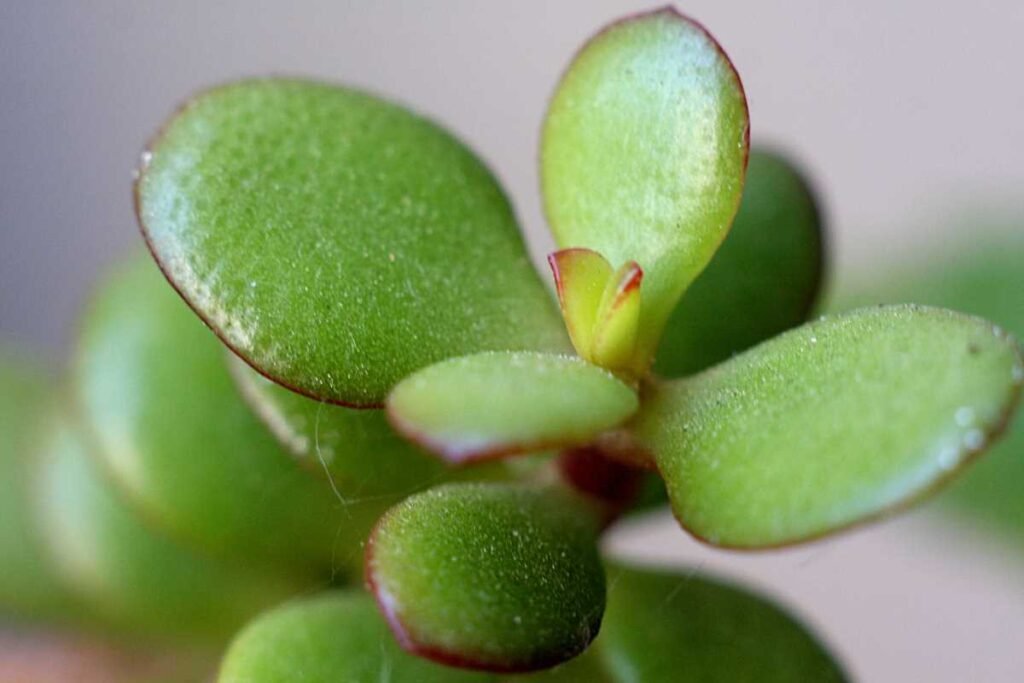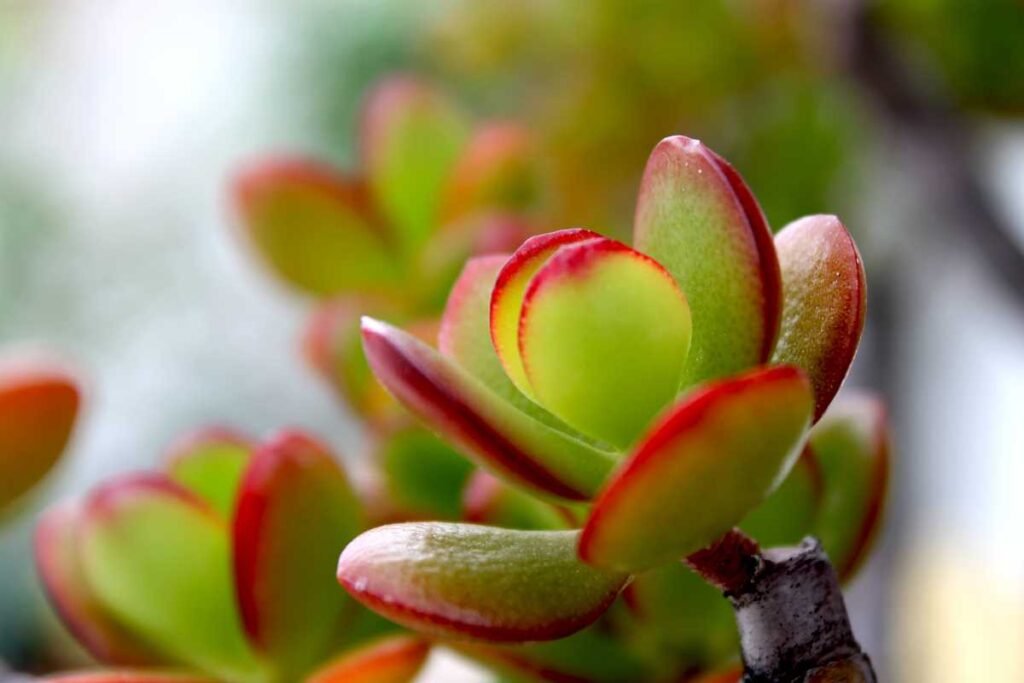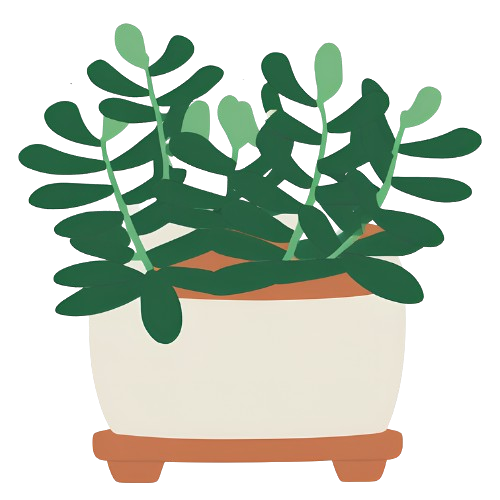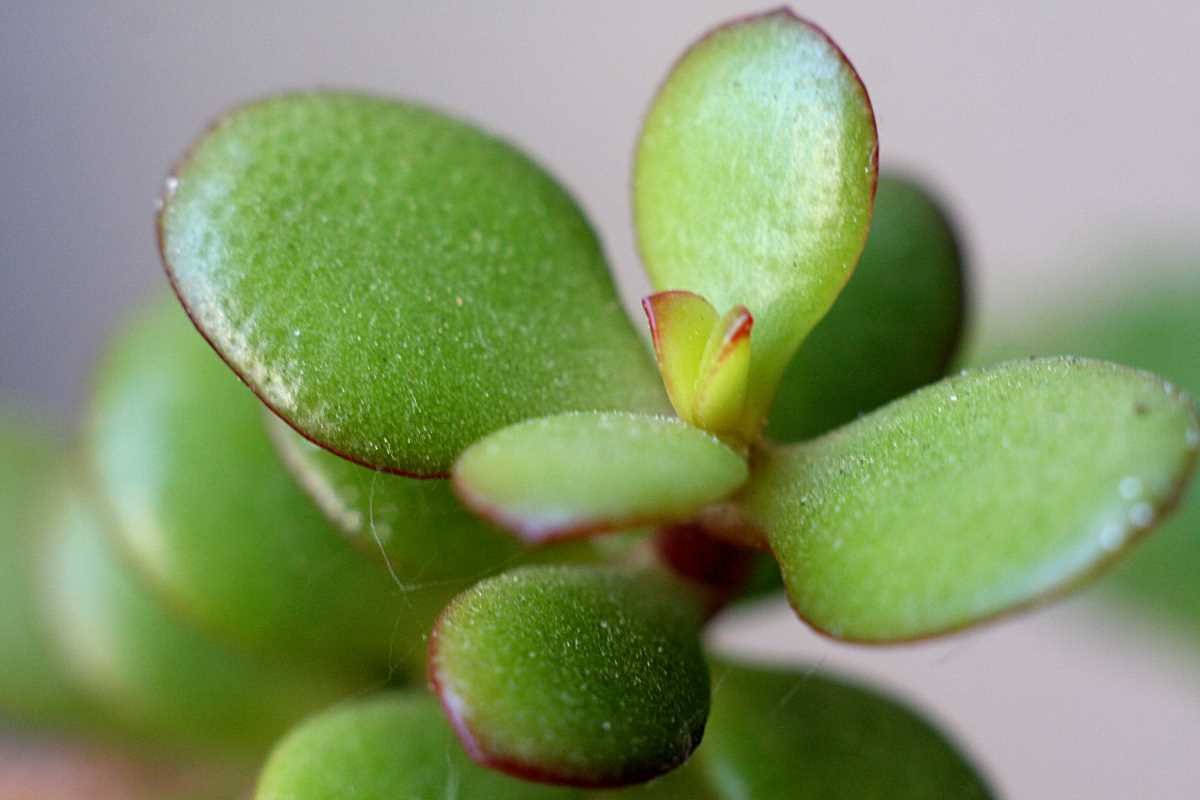Jade plants bring a bit of good luck and joy to many homes. These small trees with thick stems and oval leaves are easy to grow. You might have seen them on a sunny window sill or in an office. They last for years with the right care!
The jade plant comes from South Africa. It has the name Crassula ovata in science books. Many people call it a money plant or lucky plant too. These plants can live for a very long time – some for over 100 years!
Let’s learn all about jade plants! I’ll show you how to grow them, what they need, and why so many plant lovers keep them. By the end, you’ll know if a jade plant is right for your home.

Table of Contents
The History and Origin of Jade Plants
Jade plants grow wild in South Africa. They come from dry, rocky places in the Eastern Cape and KwaZulu-Natal. The hot days and cool nights there shaped how jade plants grow.
For many years, people in Asia have seen jade plants as lucky. The small, round leaves look like coins – a sign of wealth and good luck! In China, people often put jade plants near the front door or in money areas of the home.
Dutch traders first brought jade plants to Europe in the early 1700s. Soon, they spread around the world as easy house plants. Their skill to live with little water made them great for homes.
The name “jade plant” comes from the color of the leaves. They have a deep green that looks like the jade stone. The jade stone stands for wisdom and peace in many cultures.
Types of Jade Plants
Did you know there are many kinds of jade plants? Each has its own look and charm. Here are some types you might find:
Classic Jade (Crassula ovata): This is the most common type. It has thick stems and oval green leaves.
Hobbit Jade (Crassula ovata ‘Hobbit’): The leaves curl at the tips and look like tiny tubes!
Gollum Jade (Crassula ovata ‘Gollum’): Named after the Lord of the Rings role, it has long, tube-like leaves.
Variegated Jade (Crassula ovata ‘Variegata’): These have cream or white marks on the leaves.
Silver Jade (Crassula arborescens): The leaves have a blue-gray look with red tips in bright light.
Miniature Jade (Crassula ovata ‘Minima’): A small form that grows just a few inches tall.
Pink Jade (Crassula ovata ‘Pink Beauty’): The leaf edges turn pink in cool or bright light.
Each type needs the same basic care, but they add their own style to your plant set!
Also read, Curly Jade Plant (Ripple Jade): Everything You Need to Know.
Why Choose a Jade Plant?
Why do so many plant fans love jade plants? Here are some top draws:
They last a long time. With good care, jade plants can stay with you for many years, even ages! They can grow into small trees over time.
They’re hard to kill. Jade plants store water in their leaves and stems. This means they can live if you forget to water them now and then.
They look good all year. Jade plants stay green and full all year long. Some even bloom with small star-like white or pink flowers in the winter.
They bring good luck. In Feng Shui, jade plants draw wealth and luck. Many keep them in homes or shops for this.
They clean the air. Like many plants, jades help clean the air in your home.
They’re easy to share. You can grow new jade plants from just a leaf or stem cut from your plant.
They need little room. Jade plants grow slowly and can stay small for years if you want.
With all these good points, it’s clear why jade plants are such well-liked house plants!
How to Care for Your Jade Plant

Now let’s get to the heart of it – how to keep your jade plant happy and well! The good news is that jade plants are some of the most easy-going plants you can find.
Light Needs
Jade plants love bright light. Put them near a south or west-facing window if you can. They need at least 4 hours of sun each day.
Too little light will make the plant grow tall and thin as it looks for more sun. The stems may be weak, and the plant might not look full and lush.
Don’t put your jade in full, hot sun right away – it can burn! Move it to more sun bit by bit to help it get used to it.
In winter, jade plants can do well with less light. But they may grow more slowly.
Water Needs
Here’s where jade plants shine – they don’t need much water! These plants store water in their thick leaves.
Let the soil dry out fully between drinks. Then, water well and let all the extra water drain out. Never let your jade sit in water.
In spring and summer when the plant grows more, you’ll need to water more often – maybe once a week. In fall and winter, cut back to once every 2-3 weeks.
How can you tell if your jade needs water? The leaves may look a bit soft or flat. The soil will feel dry when you stick your finger in an inch or two.
Too much water is the main way jade plants die. It leads to root rot, which makes leaves turn yellow and fall off. When in doubt, wait a day or two before you water.
Soil and Pot Choice
Jade plants like soil that drains well. They come from dry areas, so they don’t like wet feet!
A mix made for cacti and dry-land plants works well. Or make your own mix with:
- 2 parts all-use soil
- 1 part sand or small rocks
- 1 part perlite or pumice
For pots, pick ones with drain holes. Clay or terra cotta pots work great as they let extra water out through the sides.
Start with a small pot. Jade plants like to be a bit root-bound. Move up to a pot just 1-2 inches wider when the plant gets too big for its home.
Temp and Humidity
Jade plants like the same temps we do! They grow best in temps from 65°F to 75°F in the day, and not below 50°F at night.
Keep jade plants away from cold drafts or heat vents. Big swings in heat can harm them.
In terms of wet air, jade plants are fine with the dry air in most homes. You don’t need to mist them or use a wet air maker.
If you live where it’s hot in summer, you can move your jade plant to a shady spot in the yard. Just bring it back in when the nights get cool.
Food for Your Jade
Jade plants don’t need much plant food. Too much can harm them!
Feed them once every 3-4 months in spring and summer with a food made for dry-land plants. Use half the dose the box says.
Don’t feed jade plants in fall or winter, as they grow less then.
If your jade gets too much food, you may see white salt marks on the soil or plant. If this happens, rinse the soil well with clean water.
Pruning and Shaping
One of the fun things with jade plants is that you can shape them like tiny trees! This art is called bonsai.
Prune your jade in spring or summer. Use clean, sharp clips to cut stems just above a leaf or node.
Don’t cut off more than a third of the plant at once. This could shock it.
After each cut, let the wound dry and form a skin for a few days before you water. This stops rot.
Save the bits you cut off – you can grow new plants from them!
Signs of Jade Plant Woes
Even though jade plants are tough, they can have some problems. Here are signs to watch for:
Brown spots on leaves: This could mean too much sun or sun burn.
Yellow leaves that fall off: Often a sign of too much water.
Soft, mushy stems: This is a clear sign of rot, often from too much water.
Shrunken, flat leaves: Your plant needs a drink!
White, fuzzy spots: This might be mealy bugs. Wipe them off with a cotton swab dipped in rubbing spirits.
Flat, brown bumps on stems: These are scale bugs. Use the same fix as for mealy bugs.
Leaves drop when you touch them: The plant could be too cold or got a cold shock.
If you see any of these signs, act fast to fix the cause. Jade plants can bounce back well if you catch problems early!
How to Make More Jade Plants
One of the best things about jade plants is how easy they are to grow from cuttings. This means you can make new plants from your first one!
Leaf Cuttings
This is the slow way but it works well:
- Pick a plump, whole leaf. Give it a small twist to take it off the stem.
- Let the leaf sit for 1-2 days to form a skin on the cut.
- Lay the leaf on top of dry cactus soil.
- Place in bright, not hot, light.
- Wait! After a few weeks, you’ll see tiny roots and then a small plant form.
- Once the baby plant is about an inch tall, you can start to water it gently.
Stem Cuttings
This way is faster:
- Cut a stem 2-4 inches long with clean clips.
- Take off the lower leaves to leave 1-2 inches of bare stem.
- Let the cut end dry for 3-7 days till it forms a skin.
- Stick the stem about an inch deep in dry cactus soil.
- Wait 2-3 weeks for roots to grow before you water.
- Place in bright light, but not hot sun.
The best time to take cuttings is in spring or summer when the plant is in its growth time.
Guess what? You can share these new plants with friends or grow your own jade plant farm!
Jade Plants and Feng Shui
In Feng Shui, the old Chinese art of space flow, jade plants have a key role. They’re seen as plants that bring wealth, luck, and good flow.
The round leaves of the jade plant look like coins – a sign of wealth to come. The deep green color stands for growth and life.
For the best luck, Feng Shui fans say to put your jade plant:
- In the east part of your home to boost family health
- In the south for fame and good name
- In the south-east to draw wealth
- Near the front door to pull good luck into your home
Some tips from Feng Shui for jade plant care:
- Keep the plant healthy – a dying plant can mean bad luck
- Wipe the leaves now and then to keep them bright
- Don’t keep a jade plant in the bed room – it’s seen as too much yang (warm) energy
While these thoughts come from Feng Shui, many plant fans just like the calm vibe that jade plants add to a space!
Jade Plants Around the World
Jade plants have found homes all over the world, far from their South African roots. Let’s see how they fit into plant life in some places:
Asia: In parts of Asia, jade plants are top picks for homes and shops. In China, they’re called “money plants” and are given as gifts for new homes or shops.
Europe: In cold parts of Europe, jade plants are kept as house plants. In warm spots like Spain or Greece, they may grow in yards.
United States: Jade plants grow well in the dry, warm parts of the U.S. like California and Arizona. In cold states, they stay in pots that can come in for winter.
Australia: The hot, dry parts of Australia are great for jade plants. They grow well there and can get quite big!
In each place, jade plants have made a mark for their good looks and ease of care.
Jade Plants in Pop Culture
Jade plants show up in books, shows, and more:
- In the film “Crazy Rich Asians,” jade plants sit in key spots in the rich homes shown.
- They show up in a lot of home style shows as easy plants that add a pop of green.
- The plant app “Plant Nanny” has a jade plant role to help you track your water use.
- Some songs use “jade plant” as a sign of calm and peace.
Facts of Jade Plant That May Shock You
Here are some fun facts about jade plants you might not know:
- Some jade plants can live for over 100 years! With the right care, your jade plant might be with you for life.
- In the wild, jade plants can grow up to 10 feet tall! They look like small trees, not the small house plants we know.
- The sap from jade plants was used by some tribal groups to treat warts and corns.
- Jade plants can bloom! If they get the right light and cool nights, they make small star-like white or pink blooms, most often in late winter.
- In South Africa, jade plants were once used in tribal rites to bring rain in dry times.
- There are more than 1,400 types of plants in the big plant group that jade plants come from.
- Jade plants can help clean the air in your home by taking in bad stuff and giving off clean air.
- The Jade plant was first shown to the West in the 1700s, but it was grown as a house plant in Asia for much more time.
Are Jade Plants Safe?
If you have kids or pets, you might want to know – are jade plants safe to have at home?
Jade plants are mildly toxic if eaten. They have a bit of a bad taste, so most pets and kids don’t try to eat much. But it’s still best to keep them out of reach.
If a child or pet eats part of a jade plant, they might have:
- Tummy pain
- Being sick
- Slow heart rate in rare cases
If you think your child or pet ate a jade plant, call your doctor or vet to ask what to do.
Most times, jade plants and homes with kids and pets can live side by side with no woes. Just put the plant up high or in a room your pets don’t go in.
Jade Plant Care By Time
Let’s break down jade plant care tasks by time:
Daily: Check for signs that your plant needs water or has bugs.
Weekly (in growth time): Water when soil is dry; check light needs.
Monthly: Clean dust off leaves with a soft, damp cloth; turn the pot so all sides get the same light.
Three to four times a year: Feed with plant food (spring and summer only).
Twice a year: Check if your plant needs a new pot (spring is best); prune to shape if you like.
Once a year: Move the plant back in from the yard when fall comes if you had it out for summer.
This time plan is just a guide – your own jade plant may need more or less care based on where you live and the plant’s age.
Jade Plants in Small Spaces
Live in a small place? Jade plants can still work for you! Here’s why they’re great for small homes:
- They grow slowly and can stay small for years in a small pot.
- They don’t need to be moved to a new pot often – they like to be a bit root-bound.
- They’re fine with the dry air in most homes and flats.
- They don’t drop leaves all over like some plants.
- They need just a small sunny spot to thrive.
For the best jade plant in a small space:
- Pick a small type like Crassula ovata ‘Minima’
- Use a small pot that won’t take up too much room
- Put it on a wall shelf near a sunny window to save floor space
- Prune it now and then to keep it small and neat
With these tips, you can still have the luck and joy of a jade plant, even in the most snug flat!
Final Thoughts on Jade Plants
Jade plants truly are one of the best plants for both new and old plant fans. They mix ease of care with good looks and long life in a way few other plants can.
If you have a bright spot in your home and can hold back on the water, a jade plant could bring you years of green joy. They need so little from us, yet give back so much in the form of clean air, calm feels, and even a bit of luck if you buy into the Feng Shui side!
The jade plant’s skill to live in dry times and still stay green and full is a good life hint too. It shows us that with the right base and care, we can all grow and thrive.
So why not add a jade plant to your home? Start with a small one, and watch it grow with you through the years. Who knows – it might just bring you some good luck too!

